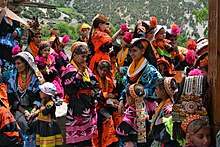شعب الدرد
المظهر
شعب الدرد
| اللغة الأم | |
|---|---|
| اللغة المستعملة | |
| فرع من | |
|---|---|
| مجموعات ذات علاقة |

شعب الدرد هي من مجموعة من الشعوب الهندوآرية الموجودة في شمال باكستان وشمال الهند وشرق أفغانستان. وهم يتحدثون بالغات الدردية، التي تنتمي إلى عائلة الهندوآرية. أكبر عدد من شعب الدرد يتواجدون في غلغت-بلتستان وخيبر بختونخوا، باكستان وفي وادي كشمير ووادي شيناب في الهند. وتوجد أعداد قليلة من شعب الدرد في لداخ في الهند وشرق أفغانستان.[3] والدرد هم أكبر مجموعة في الشعب الكشميري، ويبلغ عدد الشعب الكشميري أكثر من 5.5 مليون نسمة.[4] يدين أغلبهم بالإسلام السني مع وجود أقلية شيعية أغلبهم إسماعيلية، وتدين قبيلة الكيلاش بالهندوسية.[5][6][7] ، وكذلك بانديت الكشمريريون.[1] وفي قريتي هانوّ ودا في لداخ، ومنقطة بروكبا يُدينون بالبون (ديانة تبتية قديمة، قبل دخول البوذية إلى التبت).[2]
المراجع
[عدل]- ^ ا ب Harris، Ian Charles (1994). Longman guide to living religions. Stockton. ISBN:978-1-56159-089-6. مؤرشف من الأصل في 2019-12-08.
- ^ ا ب The India magazine of her people and culture, Volume 14. A. H. Advani. مؤرشف من الأصل في 2016-06-09. اطلع عليه بتاريخ 2007-08-01.
Dardic religion in Ladakh, particularly in the villages of Da and Hann, retains marked traces of the pre-Buddhist animistic religion, Bon-chos.
- ^ "List of Scheduled Tribes". Census of India: Government of India. 7 مارس 2007. مؤرشف من الأصل في 2010-06-05. اطلع عليه بتاريخ 2012-11-27.
- ^ "Kashmiri" [en]. ethnologue.com (بالإنجليزية). Archived from the original on 2019-06-06. Retrieved 2020-04-18.
{{استشهاد ويب}}: الوسيط غير المعروف|t itle=تم تجاهله (help) - ^ West, Barbara A. (19 May 2010). Encyclopedia of the Peoples of Asia and Oceania (بالإنجليزية). Infobase Publishing. p. 357. ISBN:9781438119137. Archived from the original on 2019-10-27.
The Kalasha are a unique people living in just three valleys near Chitral, Pakistan, the capital of North-West Frontier Province, which borders Afghanistan. Unlike their neighbors in the Hindu Kush Mountains on both the Afghani and Pakistani sides of the border the Kalasha have not converted to Islam. During the mid-20th century a few Kalasha villages in Pakistan were forcibly converted to this dominant religion, but the people fought the conversion and once official pressure was removed the vast majority continued to practice their own religion. Their religion is a form of Hinduism that recognizes many gods and spirits ... given their Indo-Aryan language, ... the religion of the Kalasha is much more closely aligned to the Hinduism of their Indian neighbors that to the religion of Alexander the Great and his armies.
- ^ Bezhan, Frud (19 Apr 2017). "Pakistan's Forgotten Pagans Get Their Due" (بالإنجليزية). إذاعة أوروبا الحرة. Archived from the original on 2019-07-24. Retrieved 2017-07-11.
About half of the Kalash practice a form of ancient Hinduism infused with old pagan and animist beliefs.
- ^ Minahan, James B. (10 Feb 2014). Ethnic Groups of North, East, and Central Asia: An Encyclopedia (بالإنجليزية). ABC-CLIO. p. 205. ISBN:9781610690188. Archived from the original on 2017-02-17. Retrieved 2016-06-26.
Living in the high mountain valleys, the Nuristani retained their ancient culture and their religion, a form of ancient Hinduism with many customs and rituals developed locally. Certain deities were revered only by one tribe or community, but one deity was universally worshipped by all Nuristani as the Creator, the هندوس god Yama Raja, called imr'o or imra by the Nuristani tribes. Around 700 CE, Arab invaders swept through the region now known as أفغانستان, destroying or forcibly converting the population to their new Islamic religion. Refugees from the invaders fled into the higher valleys to escape the onslaught. In their mountain strongholds, the Nuristani escaped conversion to Islam and retained their ancient religion and culture. The surrounding Muslim peoples used the name Kafir, meaning "unbeliever" or "infidel," to describe the independent Nuristani tribes and called their highland homeland Kafiristan. The Nuristani are sometimes called Kalasha though this name is more appropriate for the closely related Kalash in the neighboring Chitral region of Pakistan. The differences between the Nuristani and the Kalash are religious as the Kalash mostly retain their ancient religious beliefs.
